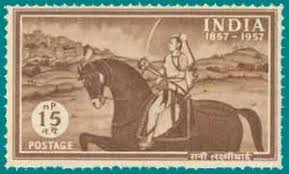


Today we pay tribute to Lakshmi Bai – the Rani (queen) of Jhansi
– killed in battle one hundred and fifty-three years ago by British
Imperialists during India’s First War of Independence. She was
twenty-two years old. The story of this freedom-fighting warrior heroine
is the stuff of legend. Like Boudicca, she trained and personally led
an army against occupying forces. Like Joan of Arc, she rode into battle
dressed as a man. And, like the fictitious Scarlet Pimpernel, so
mysterious and mythologised is the Rani that it’s difficult to identify
the truth. Was she beautiful, as most accounts claim? Or was her face
disfigured by smallpox? Was she a diplomatic head of state, or a
ruthless and cunning warrior? Even the details of her death are
uncertain. Many Western sources cite the date as 17
th June 1858, while orthodox Indian references state the 18
th.
According to some versions, she died riding into battle against the
British. Others say that she was shot while holding the ramparts of
Gwalior Fort. Whatever the truth, the story of a female leader battling
for her kingdom against the might of the British fired the Indian
nationalistic imagination. During the long struggle for freedom, it was
the Rani of Jhansi who served as the emblematic symbol of resistance.
So
how did this real-life Xena manage to lead an army in the modern era,
in direct opposition to the perceived notions of nineteenth-century
Indian (and worldwide) feminine decorum?
In 1848, the power-hungry
British East India Company under the leadership of Lord
Dalhousie adopted the “doctrine of lapse” – allowing the British to
annex an Indian state if the ruler did not have a male heir. Resistance
to the policy, and the subsequent Great Rebellion of 1857, brought the Rani of Jhansi – the young widow of the last ruler of the
state of Jhansi – into the political spotlight. After Jhansi “lapsed” to
the British in 1854, the Rani repeatedly petitioned the British for her
adopted son’s rightful inheritance. To Dalhousie she wrote: “It is
notorious, my Lord, that the more powerful a state … the less disposed
it is to acknowledge an error or an act of arbitrary character.” She
later appealed to the Court of Directors of London, writing that the
lapse represented a “gross violation and negation of the Treaties of the
Government of India.” Her diplomatic pleas were rejected.



When
British army Sepoys (Indian-born soldiers) rebelled in Jhansi, the Rani
was held accountable despite her lack of involvement in the mutiny. In
retaliation, the British army led by Major-General Sir Hugh Rose
attacked Jhansi in March 1858, and laid siege upon the fort. Lakshmi Bai
escaped and was tracked to Banda, where Rose’s forces reported that “…
though the fellows did their utmost, she got away … She is a wonderful
woman, very brave and determined. It is fortunate for us that the
[Jhansi] men are not all like her.” In June 1858, 20,000 Indian rebels
led by the Rani – donned in full warrior’s regalia – mounted an attack
on Rose’s forces outside Gwalior. And it was here that the queen met her
death. Rose wrote of his foe: “The Rani was remarkable for her bravery,
cleverness and perseverance; her generosity to her Subordinates was
unbounded. These qualities, combined with her rank, rendered her the
most dangerous of all the rebel leaders.” The British captured Gwalior
three days later, and burnt the royal library containing thousands of
ancient Sanskrit scriptures.
In 1942, an all-women regiment of the
Indian National Army formed to fight British colonial rule, was named
in honour of the Rani of Jhansi. She was a most potent symbol of women’s
empowerment, courage, tenacity and capacity for India – and for us all!
Letters of Maharani Lakshmi Bai



No comments:
Post a Comment